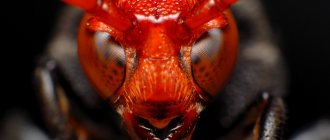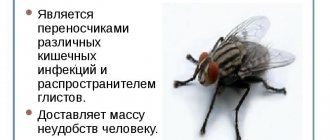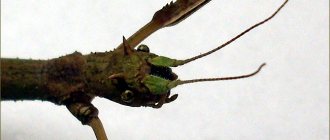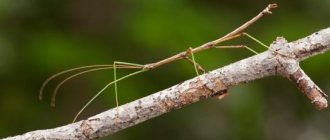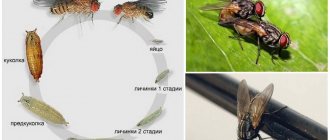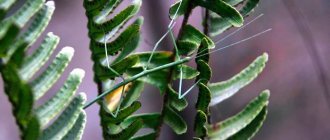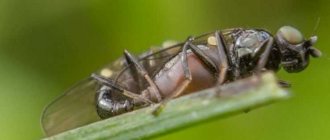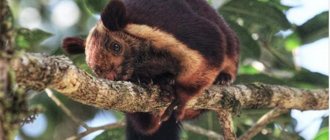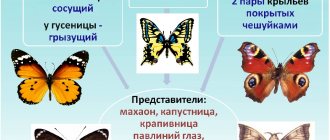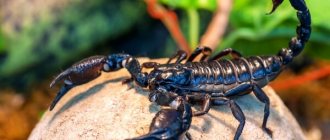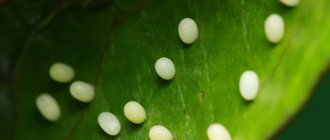Appearance, structure.
The typical color of stick insects of this species is brown, the color of dried leaves. There are also dark brown, almost black, and light green morphs. The body is covered with thorns. Adult body length: females - 10-13 cm, males 7-9 cm. Females are not only longer, but also much more massive than males. Female Australian stick insects have undeveloped wings and cannot fly; males, on the other hand, have well-developed wings and are able to fly.
Female Extatosoma tiaratum:
Male Extatosoma tiaratum:
Suriname lantern
Butterflies often inspire delight with their beauty. Compared to other representatives of its species, the Suriname lanternfly looks like an ugly duckling. Even terrible. This creature is popularly called the crocodile butterfly because of its external resemblance to alligators. Its head sometimes reaches 24 mm, which is why the light bearer, as it is otherwise called, can be confused with a lizard or a small snake. Russians are lucky: in our area it is impossible to spot a flying crocodile, but you can stumble upon a lanternfish while traveling around Latin America. By the way, you shouldn’t be afraid of its menacing appearance - the harmless insect feeds exclusively on plant sap.
Reproduction.
Australian stick insects are capable of reproducing by amphimictative (through fertilization of a female by a male) and parthenogenetic (without the participation of a male) methods. The female begins laying eggs approximately three weeks after her last molt and continues to do so throughout her life. To throw out a ripe egg, the female first folds her abdomen, and then sharply straightens it and the egg flies out of the ovipositor. The eggs are round, brown, glossy, with a black and white border and a black cap. Egg length is 4.5 mm (the first eggs may be slightly smaller). The eggs are incubated on the forest floor for six months. Some of the eggs can be carried into the nest by red-headed ants of the genus Leptomyrmex, which mistake them for plant seeds that they eat. Inside the anthill there is a stable temperature and humidity, which creates ideal conditions for incubating stick insect eggs, while eggs simply scattered on the ground can be threatened by destructive drying out and overheating... A stick insect larva that has just emerged from the egg is capable of running quickly and is similar in color to the red-headed ant, which is helps her leave the anthill without being eaten by the ants.
Development from larva to adult takes an average of 4 months, during which time the stick insect molts every two to three weeks.
rice. 4
Scorpio girls
Imagine a fly. Imagine a scorpio. Now imagine the result of their crossing. A similar creature lives in the nature of the Northern Hemisphere. This monster is called a scorpion, it has a proboscis similar to the beak of a toucan, wings, and a stinger like a real scorpion. Even despite its small size (only 3.5 centimeters), this insect would cause discomfort if encountered. In the south of Western Siberia, these creatures often damage the silvercurrant crop.
The scorpion was discovered in 1904, and was then mistaken for a flying scorpion. Today the animal is well studied, more than 700 species are already known. None of them are capable of killing a person or any other creature - mainly these harmless but frightening monsters feed on carrion and plants.
Keeping in captivity.
Conditions of detention
An insectarium with a size of 50x25x25 (length, width, height) is suitable for keeping 3-4 adult individuals. An ordinary rectangular aquarium covered with a mesh lid is suitable as an insectarium:
One stick insect requires approximately 10 liters of aquarium volume. A denser planting can lead to the death of insects - stick insects will damage each other after molting... It is important that the materials from which the insectarium is made are waterproof and non-toxic. For normal functioning of stick insects, high air humidity is required. This is achieved by having constantly moist soil in the insectarium (peat, a mixture of peat and soil), as well as daily spraying with clean, settled water at room temperature. It is especially important to maintain high humidity when stick insects molt. If there is insufficient humidity, even the death of the insect after an unsuccessful (partial) molt is possible. The soil (peat) in the insectarium should be tightly compacted (this will make it easier to sweep eggs and feces from it). For cleaning, you can use a dustpan with a long handle and a large wide brush (you need to remove waste regularly, otherwise mold will appear that can destroy the eggs):
Before filling in the peat, you can add a layer of small pebbles or sand as drainage. Feeding branches of plants should be placed in water, in a container with a very narrow neck (so that feces, eggs and insects themselves do not get into the water). The photograph shows a variant of such a vessel - it is a plastic jar with a hole made in the lid for branches, inserted into a ceramic pot dug into the ground:
The temperature in the insectarium should be within + 20-25 degrees C. In other words, room temperature is enough and there is no need for additional heaters (especially since heating, for example, with an incandescent lamp will dry the air).
Feeding
The main food for Australian stick insects in captivity is raspberry leaves. In addition to raspberries, you can also provide stick insects with branches of blackberry, rose, oak, rowan, and rosehip. In winter, in the absence of leaves of the listed plants, you can feed stick insects with some plants cultivated at home: Chinese rose (Hibiscus rosa-sinensis), Ficus benjamina. In addition, when you can no longer get fresh raspberries, you can feed stick insects with strawberry and river grass leaves, which remain green almost all year round, so you can get them even from under the snow... It is important that the leaves are not treated with any pest control drugs... You should not give stick insects recently blossomed branches of plants whose leaves are covered with a protective adhesive film, for example, birch and hawthorn leaves. Raspberries and rowan do not have such a film.
The leaves of Geum rivale remain green all year round and can be fed to Australian stick insects in winter and early spring:
Breeding
Layed eggs should be collected and placed in a separate incubator container with moist filler soil. Peat, sphagnum moss, coconut shavings or synthetic filler can be used as filler. The advantage of synthetic materials is that they are less likely to develop mold. The incubator must have a mesh lid. The required humidity is maintained through regular spraying. Temperature indicators are the same as when keeping adult insects. The incubation period lasts about six months.
After hatching from the eggs, the larvae look like ants and are very mobile. Their body is slimmer and darker (dark brown, black) than that of adult insects, their head is red-orange (see Fig. 4). After the second moult, the stick insect already looks like an adult, but it still does not have wings:
During the first 24 hours after molting, you should never pick up a stick insect, try to move it somehow, etc. (the integument is still soft at this time and the insect can be easily damaged). Wings appear after the larva transforms into an adult insect (after the sixth molt). About three weeks after this, females begin to lay eggs and do so for the rest of their lives. One female is capable of laying several hundred eggs. But not all eggs (especially with asexual reproduction) will hatch into larvae. As already written above, the larvae are fed the same food as adult insects. For the first 2-3 days of life, the larvae do not eat anything, they only drink (but despite this, food should already be present in the insectarium so that stick insects do not run in vain in search of it).
Stick insects Extatosoma tiaratum on the leaves of river grass.
Other information
A few words should be said about the stick insect’s ability to defend itself. If the insect is disturbed, it begins to sway smoothly. It is believed that in this way the stick insect imitates the movement of a leaf in the wind. And in fact, if you place it on a branch with dry leaves, it will not be easy to distinguish the insect. The second method of defense comes into play when the stick insect realizes that its disguise has been revealed. It twists its abdomen in a spiral upward and spreads its hind legs with spikes with which, if necessary, it attacks the enemy. In addition, the insect secretes a rather unpleasant-smelling secretion.
It should be noted that stick insects should not be picked up by their limbs because they break off easily.
Giant water bugs
You can rejoice in the harsh Russian climate, if only because it does not allow some animals to exist in our country. It is unlikely that you would like meeting a giant water bug that lives in the reservoirs of the tropics of North and South America, as well as in eastern Asia. Some of the individuals of this species can reach 15 centimeters in length. These insects are excellent predators; their front legs have hooks with which they can capture and hold prey, such as a frog. Outwardly, they are not much different from ordinary bedbugs until the mating season begins. At this time, females lay eggs on the backs of males, which they are required to bear. It looks disgusting and unnatural. If you don’t know about the existence of these bugs, then when you meet one, you might think that you saw an alien creature.
Giant weta
The giant weta has the strangest appearance among the representatives of this top. If they walked on their hind legs, they could easily be confused with the coffee-loving worms from Men in Black. In reality, wetas are arthropod orthoptera creatures that live in New Zealand. These giants reach 7 centimeters in length and can weigh about 70 grams. By the way, wetes are one of the heaviest insects inhabiting the Earth. Fortunately, they are found mainly in forests and are nocturnal. They feed on plants, fruits and - very rarely - other insects. Even though they live in trees, wetes descend to the ground to lay their young.

